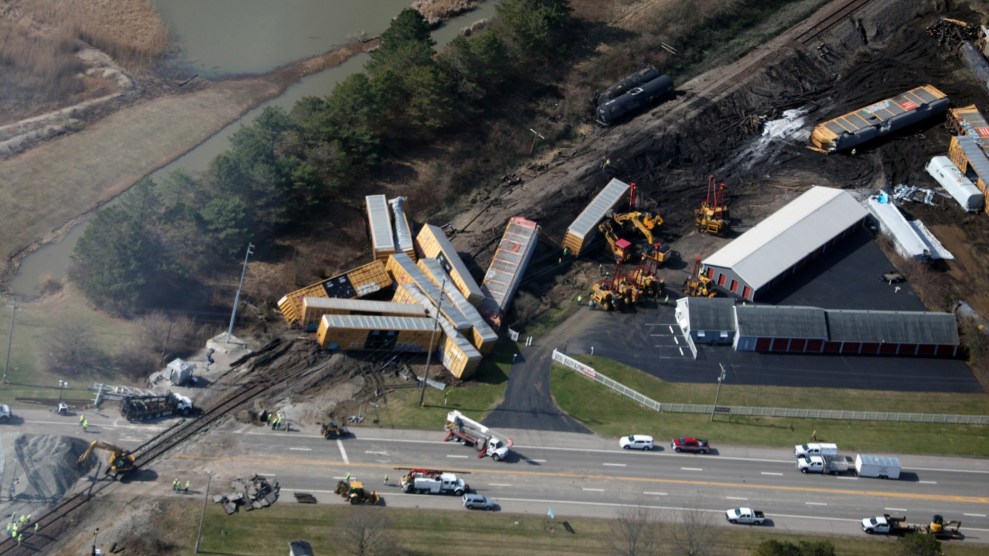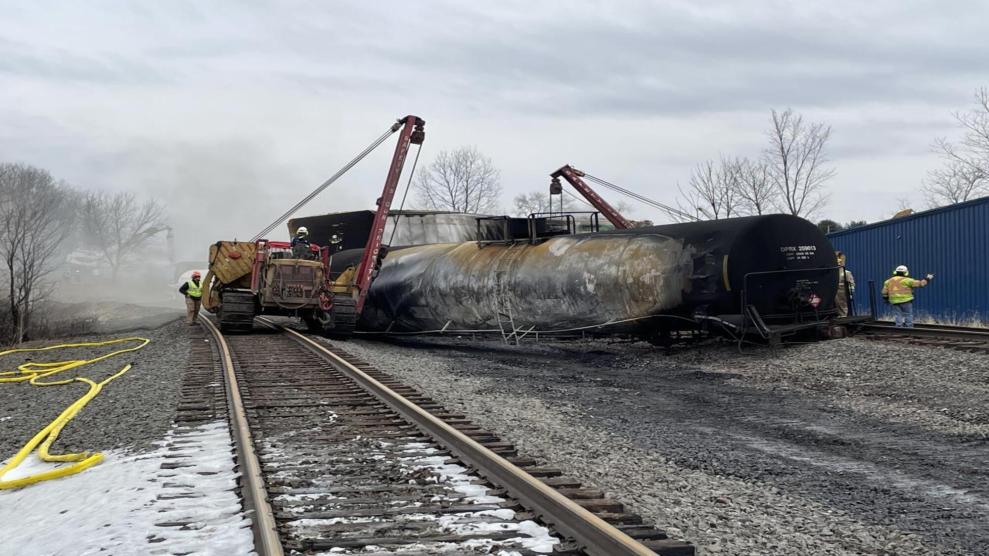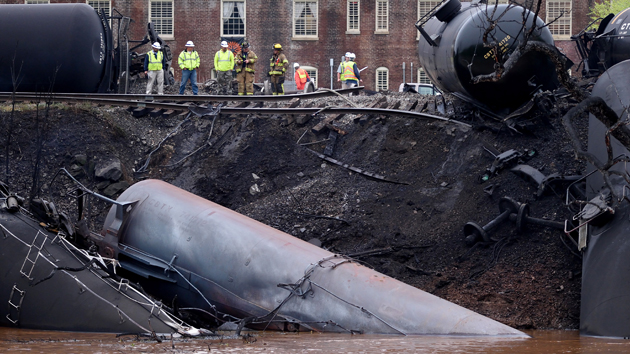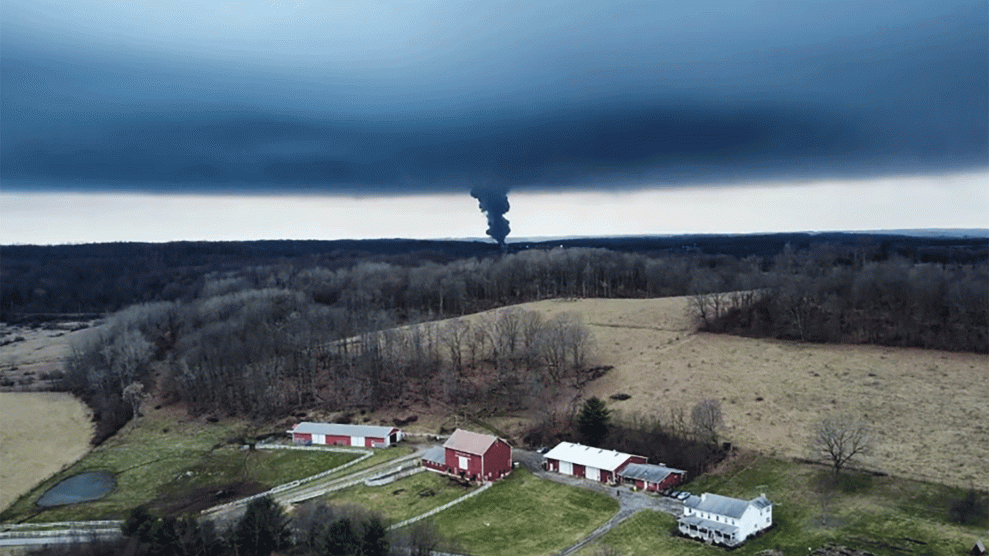
The view of the smoke funneling up from the controlled burn, as seen from a drone on Dave Anderson’s farm.Dave Anderson
This story was originally published by Slate and is reproduced here as part of the Climate Desk collaboration.
If the Norfolk Southern train that derailed in East Palestine, Ohio, last month had slid off the tracks seven minutes later, it would have been on Dave Anderson’s farm.
Echo Valley Farm, where Anderson lives with his wife and six of their children, is in Pennsylvania, about 4 miles east of where the train did derail. Which means that it is also 4 miles east of where the chemical tanks on board started leaking, and 4 miles east of where clouds of smoke from the eventual controlled burn of those chemicals floated away. On the Anderson farm, that burn meant the air was tinged with an acrid smell for over a week.
What can you be thankful for?” Anderson said on a recent phone call, of the derailment. “Well, I’m just glad it wasn’t seven minutes later.”
Here is the thing about living right next-door to a chemical spill: It really doesn’t matter how safe officials promise the spilled chemicals are. It doesn’t really matter if you understand intellectually that a controlled burn is the best way to deal with the disaster. When you are the one whose air smells different because of the train cars full of chemicals being incinerated, it feels awful and unnecessary and stupid to be anywhere near it.
That feeling is amplified for Anderson, 58, who works on his farm full time these days, but was previously employed for decades as an air traffic controller. “I have a lot of experience in transportation, safety, risk management, and weather, which are all relevant to the situation in East Palestine,” he told me. That experience did not make him feel good about the chemical spill, or the controlled burn that followed.
The night of the train derailment on February 3, Anderson was woken up around 11 p.m. by a phone call from a friend who had spoken with first responders at the crash site. His friend told him that the first responders were immediately worried about what kinds of chemicals were onboard the train, and what the ultimate damage to themselves—and the town—might be. “He called me because we were downwind of the site, so he was concerned for us,” Anderson said.
Anderson shook himself awake and “started checking on things,” including whether there were odors in the air. A weather doppler app on his phone indicated that the wind was taking smoke away from his house—but if the smoke was heading away from him, that meant it was potentially headed toward the home of friends who lived nearby with two young children. Once he confirmed his own children’s safety, Anderson called these neighbors to make sure they knew about the crash so they could decide whether or not to leave.
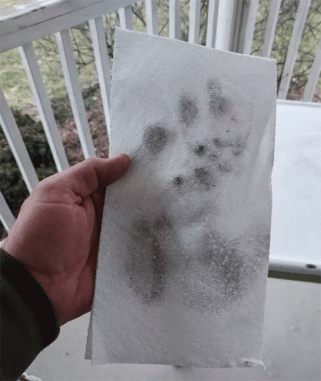
Soot from the burning chemicals settled on Anderson’s porch.
Dave Anderson
The rest of the weekend was a blur that centered on that one question—whether or not to leave. The Andersons spent the days reading the news, checking social media, refreshing their weather and wind radar apps constantly, watching the skies, and comparing notes with neighbors. Residents within 2 miles of the derailment were getting alerts on their phones telling them to evacuate, but the Andersons and many others over the county line in Pennsylvania spent the weekend hearing no official word on the incident from their elected representatives. The most up-to-date information seemed to be coming from word of mouth.
That Monday, everything snowballed. It became public that the train had been carrying carcinogenic chemicals; polyvinyl chloride, among others. An official, urgent 1-mile evacuation had been put in order; the Ohio National Guard had been deployed; a reporter had been arrested at a press conference with the governor after apparently trying to answer questions from other reporters about evacuation for surrounding residents; and there were warnings that a chemical leaking from the train—vinyl chloride, a known carcinogen used to make PVC plastic—could be explosive.
Train derailments are not uncommon in the area surrounding East Palestine—there have been nine train derailments in East Palestine since 1946. But “not uncommon” doesn’t exactly mean standard, either—a mushroom cloud of dense, acrid smoke that radiates out across miles and miles of farmland would make anyone frantic. The smoke had made many people’s tongues feel charred, Anderson said, as if they had burned them on hot coffee a week ago and they still hadn’t healed.
Ohio Gov. Mike DeWine announced at a February 6 press conference that there would be a controlled burn of the vinyl chloride later that day, citing the possibility that it might otherwise detonate and release gas uninhibitedly—potentially catapulting shrapnel within a two-mile radius. About 20 minutes later, the press conference was interrupted by an announcement by East Palestine’s fire chief that power to the press conference site and surrounding areas would be cut within 15 minutes in preparation for the controlled release. Needless to say, the entire event did little to quell the confusion and fear many locals were feeling.
Anderson was personally skeptical of the plans for the controlled burn. He kept busy around Echo Valley Farm that morning, and he couldn’t help but notice that the wind conditions that day were less than ideal: It was frigid and blustery following a dramatic drop in temperature in the early hours of the morning. This indicated to Anderson that there could be a temperature inversion, in which “heavy air density and cloud coverage could prohibit smoke from the burn from traveling upward,” he said. The smoke might “only reach a certain height in the atmosphere before it would be forced to come back down, and spread across the ground,” he said.
Around 4:30 p.m., the controlled burn began. Social media feeds began to fill up with photos of black smoke and clouded trees. Anderson, a true aviation nerd, took the small drone he uses around the farm to scope out what was going on. “The black cloud was right on the very western edge of my property, moving east,” he said, of the view from the drone. “I looked at that live on my phone and I was stunned. Like, ‘Oh God, what have they done.’”
I grew up not far from East Palestine, Ohio. I ran cross-country as a kid, and was often in the area for meets, or I’d drive through to visit my grandparents in Lebanon, Pennsylvania.
Lebanon, where my father grew up, is just a few miles from Three Mile Island—America’s very first partial nuclear meltdown. Something about the way Anderson talked about the East Palestine derailment reminded me of stories my grandfather has told me about that day in 1979 when a cooling malfunction at the nuclear plant caused a release of some radioactive gas. So I called him to talk about it.
On March 28, 1979, my grandparents were out riding their bikes. They heard the news only once they got home, and so they immediately had to wonder if they’d been exposed to radiation. They lived right on the border of the initial evacuation zone, so even though they didn’t have to leave, my grandparents decided to relocate to the church camp they ran, which was about 100 miles west. It was springtime, my grandfather recalled, and the local high schools were trying to decide whether or not they should hold their junior and senior proms.
“We clearly experienced a very scary feeling about not knowing whether we were exposed, whether we should go away … and gradually we started hearing reports from the electric company that there was no reason to be fearful,” he recalled. “And there was terrible confusion, because we wondered, did these people even know what they were talking about? This had only ever happened once before, in [the Soviet Union], and as we know now, there were eventually terrible results from that environment. We knew it some then, too,” he recalled.
My grandfather said that he and my grandmother relied heavily on information they received directly from fellow residents of their towns and the surrounding area in those early days following the partial meltdown, prioritizing that even above official statements. Just like Anderson and his family had.
“Atomic energy was a hot potato for the government. If done right, we were told, atomic energy could do wonderful things for us,” he said. “So you had the government coming in to calm us down, and there was that feeling of, ‘Can we trust them? And do they even know what they are talking about—are they just trying to cover up a terrible thing?’ ”
“The fear was very alive,” he said. “You’re talking about the potential for long-term sickness, sickness that doesn’t hit you until a later age, and you experience those kinds of questions while asking yourself whether you should stay in your home.”
That was the fear everyone in East Palestine was living with this past February: The fear of uncertainty, of not being sure what, exactly, was leaking into the water, or burning in the air. Fish were dying in streams; some residents started reporting nausea and headaches. While residents were still trying to get direct answers on whether they should head out, the media and a political circus of sorts were coming in. Right-wing politicians, inflaming fears about an American Chernobyl, began making publicity stops in the region. Democratic politicians hit back by blaming the former Trump administration for having reduced rail safety regulations (though it doesn’t seem like these regulations would have made a difference in this specific case). Soon, there were competing narratives about neglect—who or what, exactly, was at fault for the potential catastrophe unfolding in this rural community.
All of this happened before there was enough clarity to offer a concrete, established narrative. And that is why the real story here isn’t one about media neglect—although many Ohioans feel plenty acquainted with that—but of distrust. So many people affected by this accident feel distrust toward the agencies in charge of dealing with the situation, toward the transportation companies responsible, and toward the national reporters who only seem to come around for close national elections and disasters, that it quickly felt almost impossible to communicate accurately.
Anderson and my grandfather shared a deep-seated belief that when pressed, officials would put profits over people.
The Environmental Protection Agency and top Ohio officials say that tests of the air and drinking water have not shown any contamination linked to the train derailment, despite some Ohio officials telling residents as recently as Feb. 14 not to drink the water (they noted the air was safe). The EPA has since begun removing contaminated waste from the area, setting off a national kerfuffle about where to transport the soil, if soil has to be removed from the actual derailment site itself. The United States Senate is also conducting an official investigation and hearing into the derailment and its greater underlying causes, but that timeline is surely not immediate.
The problem is that the official reports didn’t do much to reassure residents—who were, and remain, extremely worried about both short-term and long-term health effects. That was also the case after Three Mile Island. Eventually, “everything turned out fine” for residents, my grandfather said, but the threat of long-term sickness remained a quiet, constant companion in the back of their minds for years before they were sure of that. The road from Three Mile Island to my grandparents’ home in Lebanon is still checkered with dead trees that stand along the bend of the Susquehanna River. Cleanup for the meltdown eventually cost a total of $987 million.
I asked my grandfather how he imagined the residents of East Palestine must be feeling. He paused before saying that the feeling of being unable to make an informed decision, the threat of a potential disaster combined with overwhelming confusion, is paralyzing.
The fear these people are feeling is real, in terms of not only that it’s happening, but that there might be some lasting damage or harm,” he said. “That’s a tough thing to live with—am I going to get sick later on? Am I going to get cancer? Is my kid going to get cancer?”
The trains were back to running within 24 hours of the crash, going along the north track because cars from the train that derailed were still sitting on the south track awaiting contamination testing. For residents who were used to barely noticing their passage, all of a sudden their presence became almost an obsession—a representation of a newfound, looming threat, and a constant reminder that their town was little more than a thoroughfare, even when it felt like it was in crisis.
So far, six class-action lawsuits have been filed representing residents of East Palestine and the surrounding area. Within a few days of the crash, Erin Brockovich was in town—by Friday afternoon, she’d been accused by Ohio State Police of no less than potentially igniting an act of domestic terrorism. On February 28, Ohio Sens. JD Vance and Sherrod Brown sent a letter to the EPA demanding that the CDC begin health screenings.
Last week, the EPA ordered the train company that was deemed responsible for the derailment, Norfolk Southern, to—in addition to footing the bill for the overall cleanup—start testing for dioxin in the area. Dioxin is a highly carcinogenic and persistent chemical compound that is produced by burning vinyl chloride gas. Ted Schettler, science director at the environmental nonprofit Science and Environmental Health Network, told STAT news: “We know when polyvinyl chloride burns it creates dioxins. I’m certain from the view of that black smoke plume that it was a witch’s brew of chemicals on fire, and I’m quite certain dioxins would be among them.” It was the same moment that froze Anderson in place on Echo Valley Farm that day.
Anderson’s experience with the train derailment reminded me so much of my grandfather’s experience after Three Mile Island. Each of them felt that it was only logical to distrust the information they were receiving; both shared a deep-seated belief that when pressed, officials would put profits over people. I don’t know if these fears are tendencies specific to people who live in this part of the country—I just suspect that it is the case because I’m from there. And while everything worked out basically fine for my grandfather, I think it’s still a bit too soon to tell for Anderson and his family. When we last spoke, he was still circling around the question of whether they should try to relocate their farm. But how does one even do that? He’s not yet sure what they’ll do—right now, he’s focusing on getting the CDC and the EPA to come do more testing.
For most of my youth, a youth I have replayed this month as I think about all of these places I know that have been at the center of this story, my favorite Ohio landmark was the “Hell Is Real” sign. Every Ohioan worth their cents knows this sign—it even got a nice write-up by Reuters in 2007. (It was mentioned in relation to another fixture of that roadway, the Touchdown Jesus, though Touchdown Jesus was eventually struck by lightning, and is no longer with us.) The “Hell Is Real” sign is on private property but is publicly admired, and seems meant to provoke fear or godliness among interstate travelers. It has become a physical manifestation of an inside joke about being an Ohioan—the Ohio vs. the World mentality that predates Ohio’s much-memed reputation for being the no man’s land at the center of it all. Florida has “Florida Man”; Ohio has a gigantic road sign warning that a burning inferno awaits us all.
When I first started following this story, the best stuff was coming from TikTok. One of the viral videos that broke the news of the crash on February 4 displayed a screenshot from a news report showing a state highway “Welcome to Ohio” sign standing in front of the raging inferno that was the derailed train. It felt like an appropriate meme to take the crown from “Hell Is Real.” Welcome to Ohio, look at this world on fire. It was just over that border from Dave Anderson’s Pennsylvania farm, after all.
